RENAULT WIND 2012 1.G Owners Manual
Manufacturer: RENAULT, Model Year: 2012, Model line: WIND, Model: RENAULT WIND 2012 1.GPages: 185, PDF Size: 5.52 MB
Page 111 of 185
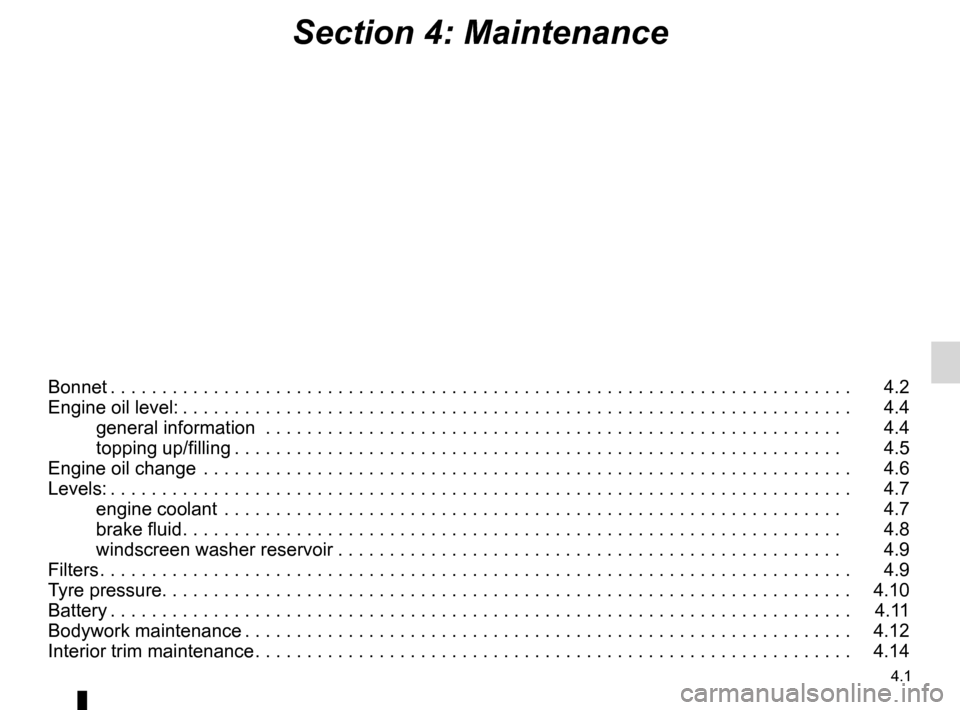
4.1
ENG_UD29997_7
Sommaire 4 (E33 - X33 - Renault)
ENG_NU_865-6_E33_Renault_4
Section 4: Maintenance
Bonnet . . . . . . . . . . . . . . . . . . . . . . . . . . . . . . . . . . . . . . . . . . . . . . . . . . . . . . . . . . . . . . . . . . . . . . . . 4.2
Engine oil level: . . . . . . . . . . . . . . . . . . . . . . . . . . . . . . . . . . . . . . . . . . . . . . . . . . . . . . . . . . . . . . . . . 4.4
general information . . . . . . . . . . . . . . . . . . . . . . . . . . . . . . . . . . . . . . . . . . . . . . . . . . . . . . . . 4.4
topping up/filling . . . . . . . . . . . . . . . . . . . . . . . . . . . . . . . . . . . . . . . . . . . . . . . . . . . . . . . . . . . 4.5
Engine oil change . . . . . . . . . . . . . . . . . . . . . . . . . . . . . . . . . . . . . . . . . . . . . . . . . . . . . . . . . . . . . . . 4.6
Levels: . . . . . . . . . . . . . . . . . . . . . . . . . . . . . . . . . . . . . . . . . . . . . . . . . . . . . . . . . . . . . . . . . . . . . . . . 4.7
engine coolant . . . . . . . . . . . . . . . . . . . . . . . . . . . . . . . . . . . . . . . . . . . . . . . . . . . . . . . . . . . . 4.7
brake fluid . . . . . . . . . . . . . . . . . . . . . . . . . . . . . . . . . . . . . . . . . . . . . . . . . . . . . . . . . . . . . . . . 4.8
windscreen washer reservoir . . . . . . . . . . . . . . . . . . . . . . . . . . . . . . . . . . . . . . . . . . . . . . . . . 4.9
Filters . . . . . . . . . . . . . . . . . . . . . . . . . . . . . . . . . . . . . . . . . . . . . . . . . . . . . . . . . . . . . . . . . . . . . . . . . 4.9
Tyre pressure. . . . . . . . . . . . . . . . . . . . . . . . . . . . . . . . . . . . \
. . . . . . . . . . . . . . . . . . . . . . . . . . . . . . . 4.10
Battery . . . . . . . . . . . . . . . . . . . . . . . . . . . . . . . . . . . . . . . . . . . . . . . . . . . . . . . . . . . . . . . . . . . . . . . . 4.11
Bodywork maintenance . . . . . . . . . . . . . . . . . . . . . . . . . . . . . . . . . . . . . . . . . . . . . . . . . . . . . . . . . . . 4.12
Interior trim maintenance . . . . . . . . . . . . . . . . . . . . . . . . . . . . . . . . . . . . . . . . . . . . . . . . . . . . . . . . . . 4.14
Page 112 of 185
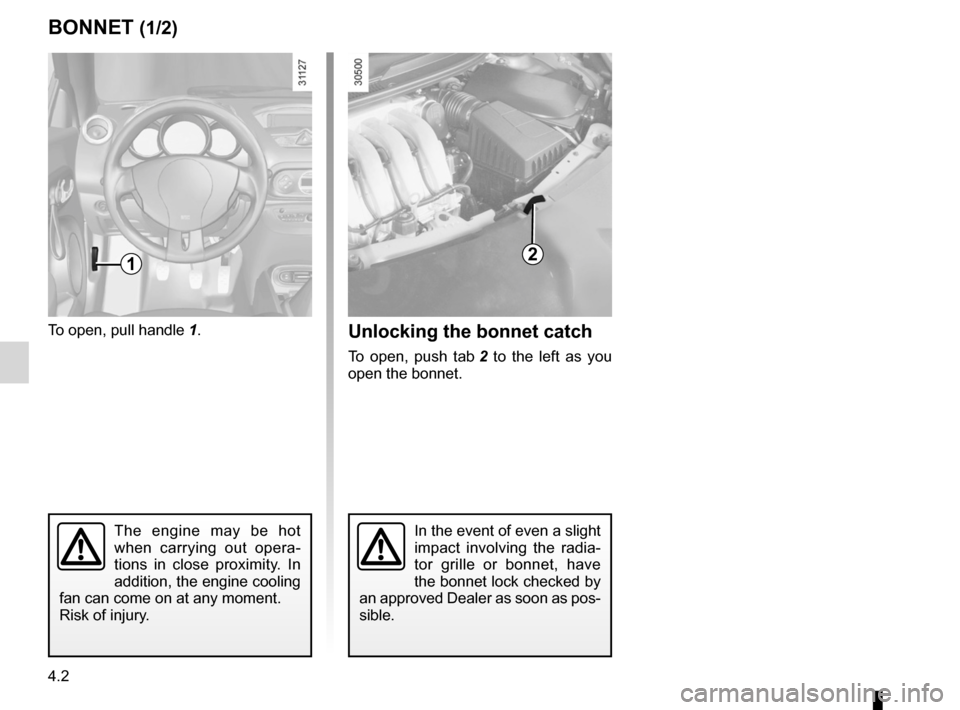
bonnet................................................... (up to the end of the DU)
maintenance: mechanical ...................................... (up to the end of the DU)
4.2
ENG_UD24357_4
Capot moteur (E33 - X33 - Renault)
ENG_NU_865-6_E33_Renault_4
Jaune NoirNoir texte
Bonnet
Bonnet (1/2)
To open, pull handle 1.
The engine may be hot
when carrying out opera -
tions in close proximity. In
addition, the engine cooling
fan can come on at any moment.
Risk of injury.In the event of even a slight
impact involving the radia -
tor grille or bonnet, have
the bonnet lock checked by
an approved Dealer as soon as pos-
sible.
21
Unlocking the bonnet catch
To open, push tab 2 to the left as you
open the bonnet.
Page 113 of 185

JauneNoirNoir texte
4.3
ENG_UD24357_4
Capot moteur (E33 - X33 - Renault)
ENG_NU_865-6_E33_Renault_4
Bonnet (2/2)
Closing the bonnet
Before closing the bonnet, make sure
that nothing has been left in the engine
compartment.
To close the bonnet, replace stay 5 in
holder 4. Hold the middle of the bonnet
and guide it down to 20 cm above the
closed position, then release. It will latch
automatically under its own weight.
54
3
opening the bonnetLift the bonnet and release stay 5 from
its holder 4 . For your own safety, it is
very important to fix the stay into re -
tainer 3 in the bonnet.
Ensure that the bonnet is
properly locked.
Check that nothing is pre -
venting the catch from lock-
ing (gravel, cloth, etc.).
After carrying out any work
in the engine compart -
ment, check that nothing
has been left behind (cloth,
tools, etc.).
These may damage the engine or
cause a fire.
Page 114 of 185
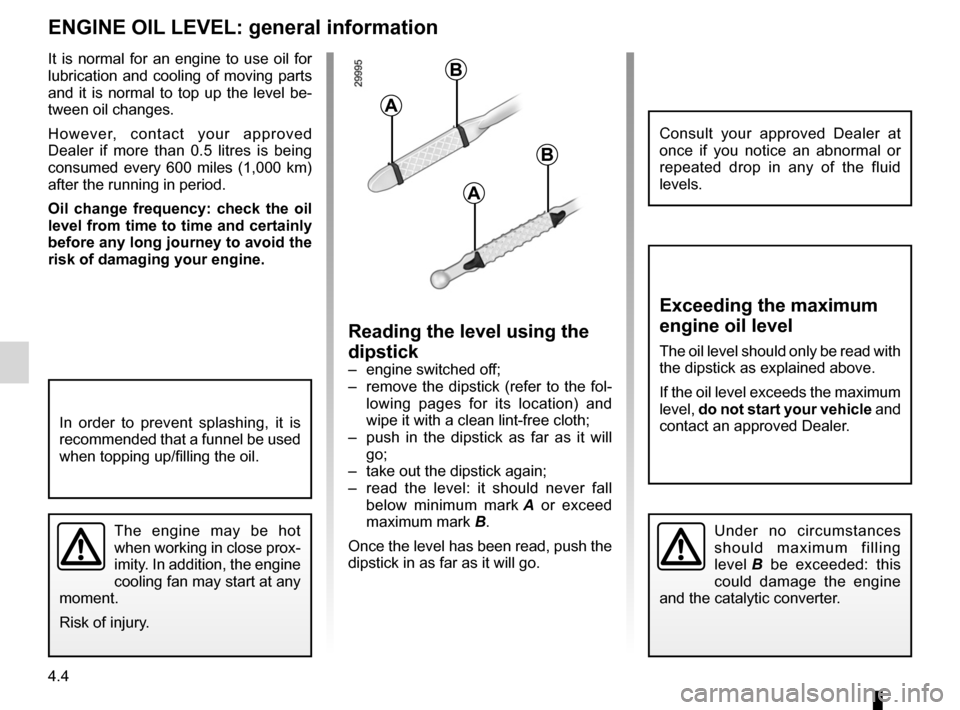
engine oil .............................................. (up to the end of the DU)
oil change ............................................. (up to the end of the DU)
engine oil level ...................................... (up to the end of the DU)
4.4
ENG_UD11215_1
Niveau huile moteur : généralités (E33 - X33 - Renault)
ENG_NU_865-6_E33_Renault_4
Engine oil level:
general information
engine oil level: general information
It is normal for an engine to use oil for
lubrication and cooling of moving parts
and it is normal to top up the level be-
tween oil changes.
However, contact your approved
Dealer if more than 0.5 litres is being
consumed every 600 miles (1,000 km)
after the running in period.
oil change frequency: check the oil
level from time to time and certainly
before any long journey to avoid the
risk of damaging your engine.
Reading the level using the
dipstick
– engine switched off;
– remove the dipstick (refer to the fol-
lowing pages for its location) and
wipe it with a clean lint-free cloth;
– push in the dipstick as far as it will
go;
– take out the dipstick again;
– read the level: it should never fall
below minimum mark A or exceed
maximum mark B.
Once the level has been read, push the
dipstick in as far as it will go.
A
A
B
B
exceeding the maximum
engine oil level
The oil level should only be read with
the dipstick as explained above.
If the oil level exceeds the maximum
level, do not start your vehicle and
contact an approved Dealer.
Under no circumstances
should maximum filling
level B be exceeded: this
could damage the engine
and the catalytic converter.The engine may be hot
when working in close prox-
imity. In addition, the engine
cooling fan may start at any
moment.
Risk of injury.
Consult your approved Dealer at
once if you notice an abnormal or
repeated drop in any of the fluid
levels.
In order to prevent splashing, it is
recommended that a funnel be used
when topping up/filling the oil.
Page 115 of 185
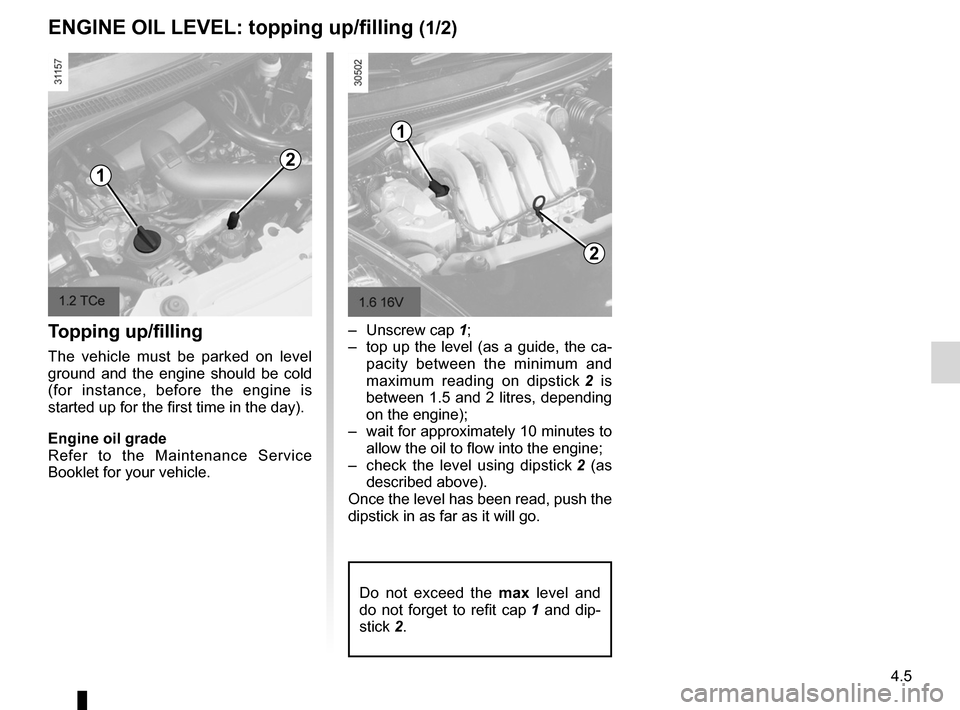
engine oil .............................................. (up to the end of the DU)
oil change ............................................. (up to the end of the DU)
engine oil level ...................................... (up to the end of the DU)
engine oil capacity ................................ (up to the end of the DU)
4.5
ENG_UD20478_2
Niveau huile moteur : appoint/remplissage (E33 - X33 - Renault)
ENG_NU_865-6_E33_Renault_4
– Unscrew cap 1;
– top up the level (as a guide, the ca-
pacity between the minimum and
maximum reading on dipstick 2 is
between 1.5 and 2 litres, depending
on the engine);
– wait for approximately 10 minutes to
allow the oil to flow into the engine;
– check the level using dipstick 2 (as
described above).
Once the level has been read, push the
dipstick in as far as it will go.t opping up/filling
The vehicle must be parked on level
ground and the engine should be cold
(for instance, before the engine is
started up for the first time in the day).
engine oil grade
Refer to the Maintenance Service
Booklet for your vehicle.
topping up/filling
engine oil level : topping up/filling (1/2)
Do not exceed the max level and
do not forget to refit cap 1 and dip-
stick 2.
12
1
2
Page 116 of 185
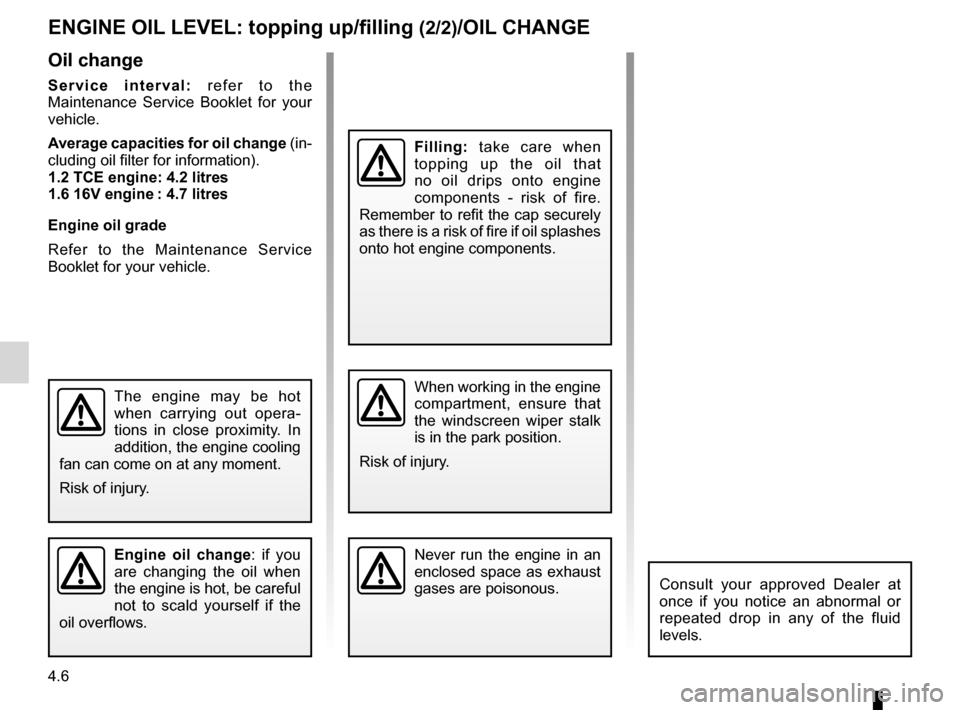
filteroil filter ............................................ (up to the end of the DU)
4.6
ENG_UD20478_2
Niveau huile moteur : appoint/remplissage (E33 - X33 - Renault)
ENG_NU_865-6_E33_Renault_4
Engine oil change
engine oil level : topping up/filling (2/2)/oil CHAnge
oil change
S e r v i c e i n t e r v a l : r e f e r t o t h e
Maintenance Service Booklet for your
vehicle.
Average capacities for oil change (in-
cluding oil filter for information).
1.2 tCe engine: 4.2 litres
1.6 16v engine : 4.7 litres
engine oil grade
Refer to the Maintenance Service
Booklet for your vehicle.
The engine may be hot
when carrying out opera -
tions in close proximity. In
addition, the engine cooling
fan can come on at any moment.
Risk of injury.
e ngine oil change : if you
are changing the oil when
the engine is hot, be careful
not to scald yourself if the
oil overflows.
Filling: take care when
topping up the oil that
no oil drips onto engine
components - risk of fire.
Remember to refit the cap securely
as there is a risk of fire if oil splashes
onto hot engine components.
Never run the engine in an
enclosed space as exhaust
gases are poisonous.
Consult your approved Dealer at
once if you notice an abnormal or
repeated drop in any of the fluid
levels.
When working in the engine
compartment, ensure that
the windscreen wiper stalk
is in the park position.
Risk of injury.
Page 117 of 185
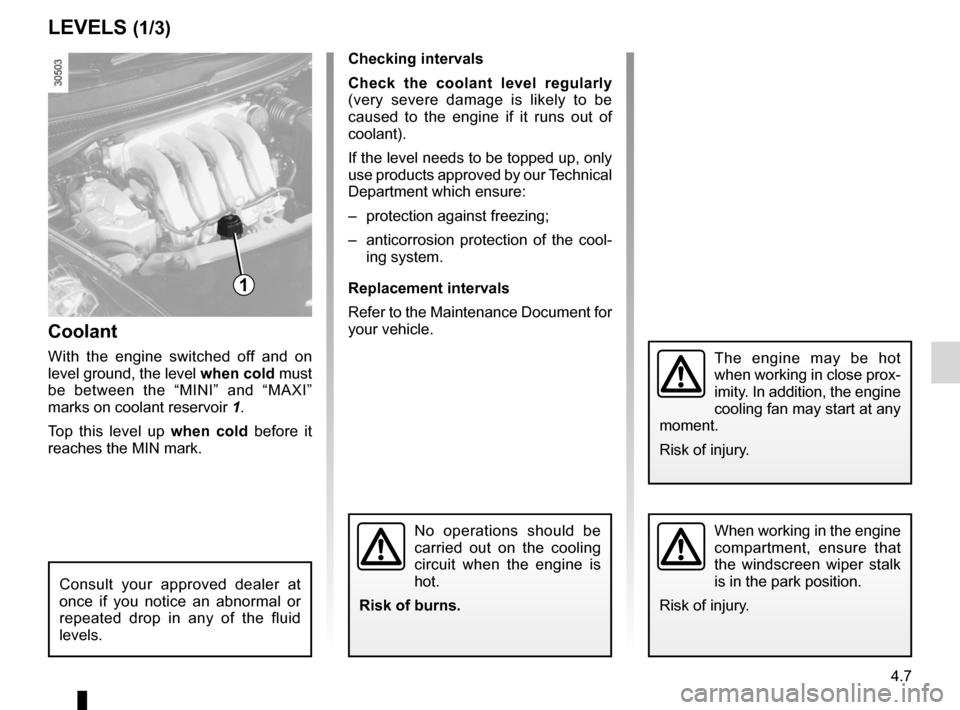
levels:coolant ............................................................. (current page)
tanks and reservoirs coolant ............................................................. (current page)
coolant ................................................................... (current page)
4.7
ENG_UD20479_2
Niveaux / filtres (E33 - X33 - Renault)
ENG_NU_865-6_E33_Renault_4
Levels:
engine coolant
levelS (1/3)
Coolant
With the engine switched off and on
level ground, the level when cold must
be between the “MINI” and “MAXI”
marks on coolant reservoir 1.
Top this level up when cold before it
reaches the MIN mark. Checking intervals
Check the coolant level regularly
(very severe damage is likely to be
caused to the engine if it runs out of
coolant).
If the level needs to be topped up, only
use products approved by our Technical
Department which ensure:
–
protection against freezing;
– anticorrosion protection of the cool -
ing system.
Replacement intervals
Refer to the Maintenance Document for
your vehicle.
No operations should be
carried out on the cooling
circuit when the engine is
hot.
Risk of burns.
The engine may be hot
when working in close prox-
imity. In addition, the engine
cooling fan may start at any
moment.
Risk of injury.
When working in the engine
compartment, ensure that
the windscreen wiper stalk
is in the park position.
Risk of injury.
1
Consult your approved dealer at
once if you notice an abnormal or
repeated drop in any of the fluid
levels.
Page 118 of 185

brake fluid .............................................................. (current page)
levels: brake fluid ........................................................ (current page)
tanks and reservoirs brake fluid ........................................................ (current page)
4.8
ENG_UD20479_2
Niveaux / filtres (E33 - X33 - Renault)
ENG_NU_865-6_E33_Renault_4
Jaune NoirNoir texte
brake fluid
levelS (2/3)
Brake fluid level
This should be checked frequently,
and immediately if you notice even the
slightest loss in braking efficiency.
The level should be read with the engine
switched off and on level ground. level 2
It is normal for the level to drop as the
brake shoes become worn, but it must
never drop lower than the
“Min” warn-
ing line.
If you wish to check the disc and drum
wear yourself, you should obtain the
document explaining the checking pro-
cedure from our network or from the
manufacturer’s website. t
opping up
After any operation on the hydraulic cir-
cuit, a specialist must replace the fluid.
Only use fluids approved by our
Technical Department (and taken from
a sealed container).
Replacement intervals
Refer to the Maintenance Document for
your vehicle.
The engine may be hot
when working in close prox-
imity. In addition, the engine
cooling fan may start at any
moment.
Risk of injury.When working in the engine
compartment, ensure that
the windscreen wiper stalk
is in the park position.
Risk of injury.
2
Page 119 of 185
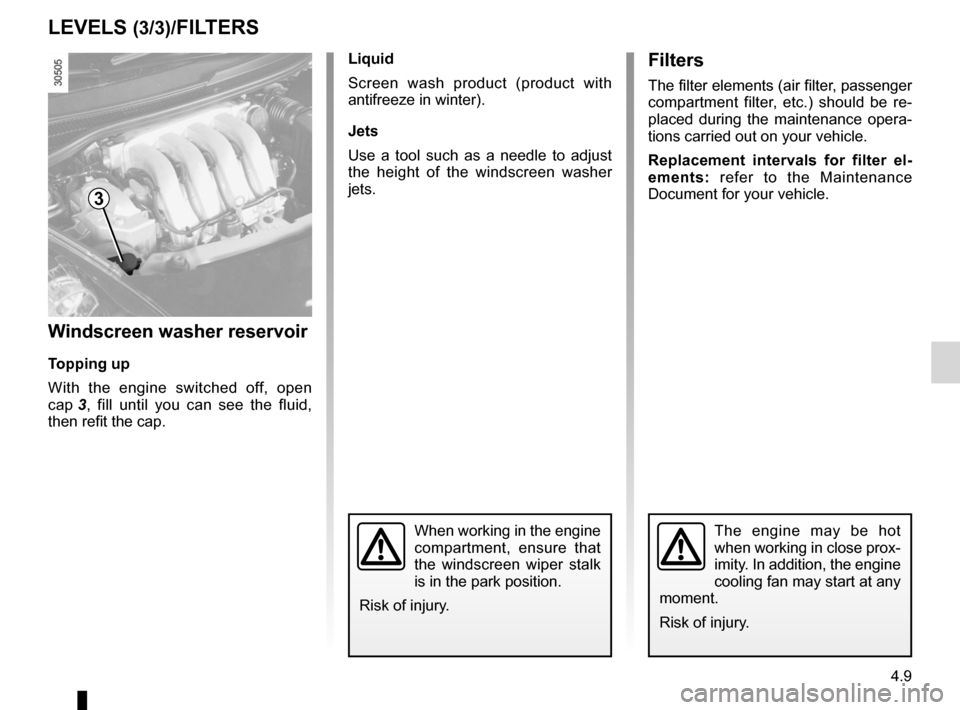
levels:windscreen washer reservoir ........................... (current page)
windscreen washer ................................................ (current page)
filter air filter ............................................................. (current page)
filter passenger compartment filter .......................... (current page)
filter oil filter ............................................................. (current page)
filter diesel filter ........................................................ (current page)
tanks and reservoirs: windscreen washer .......................................... (current page)
JauneNoirNoir texte
4.9
ENG_UD20479_2
Niveaux / filtres (E33 - X33 - Renault)
ENG_NU_865-6_E33_Renault_4
windscreen washer reservoir
Filters
levelS (3/3)/FilteRS
Windscreen washer reservoir
t opping up
With the engine switched off, open
cap 3 , fill until you can see the fluid,
then refit the cap. liquid
Screen wash product (product with
antifreeze in winter).
Jets
Use a tool such as a needle to adjust
the height of the windscreen washer
jets.
Filters
The filter elements (air filter, passenger
compartment filter, etc.) should be re
-
placed during the maintenance opera -
tions carried out on your vehicle.
Replacement intervals for filter el -
ements: refer to the Maintenance
Document for your vehicle.
When working in the engine
compartment, ensure that
the windscreen wiper stalk
is in the park position.
Risk of injury.The engine may be hot
when working in close prox-
imity. In addition, the engine
cooling fan may start at any
moment.
Risk of injury.
3
Page 120 of 185
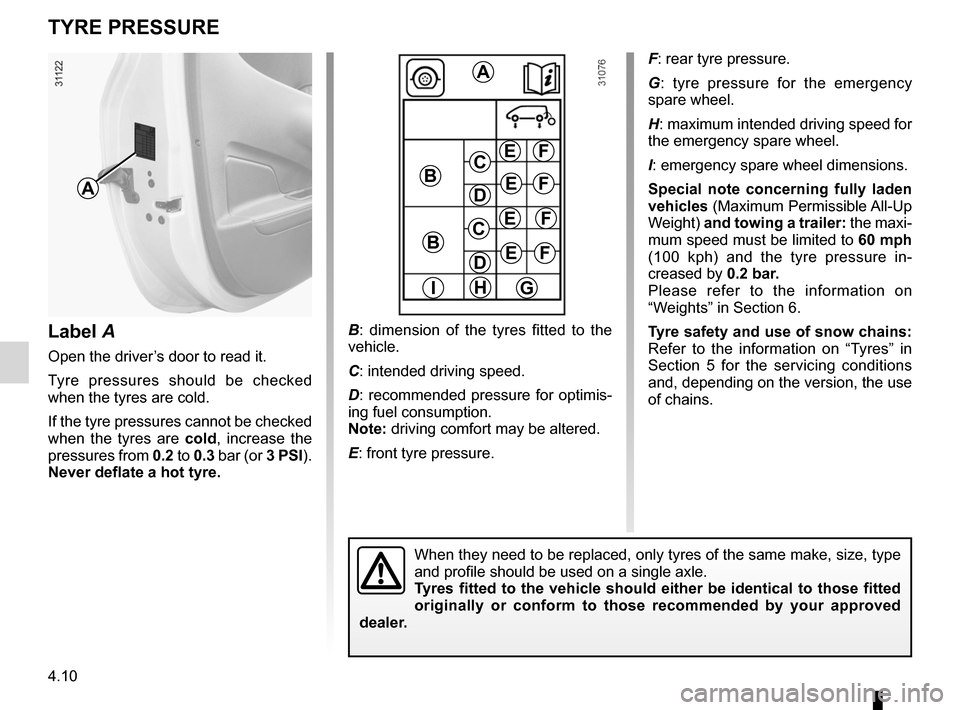
tyre pressure......................................... (up to the end of the DU)
tyre pressures ....................................... (up to the end of the DU)
tyres ...................................................... (up to the end of the DU)
4.10
ENG_UD29998_2
Pression de gonflage des pneumatiques (E33 - X33 - Renault)
ENG_NU_865-6_E33_Renault_4
Tyre pressure
tyRe pReSSURe
label A
Open the driver’s door to read it.
Tyre pressures should be checked
when the tyres are cold.
If the tyre pressures cannot be checked
when the tyres are cold, increase the
pressures from 0.2 to 0.3 bar (or 3 pSi).
never deflate a hot tyre. B
: dimension of the tyres fitted to the
vehicle.
C: intended driving speed.
D: recommended pressure for optimis-
ing fuel consumption.
note: driving comfort may be altered.
E: front tyre pressure.
A
A
B
B
i
e
e
e
eF
F
F
F
g
D
D
C
C
H
F: rear tyre pressure.
G : tyre pressure for the emergency
spare wheel.
H: maximum intended driving speed for
the emergency spare wheel.
I: emergency spare wheel dimensions.
Special note concerning fully laden
vehicles (Maximum Permissible All-Up
Weight) and towing a trailer: the maxi-
mum speed must be limited to 60 mph
(100 kph) and the tyre pressure in -
creased by 0.2 bar.
Please refer to the information on
“Weights” in Section 6.
t yre safety and use of snow chains:
Refer to the information on “Tyres” in
Section 5 for the servicing conditions
and, depending on the version, the use
of chains.
When they need to be replaced, only tyres of the same make, size, type
and profile should be used on a single axle.
t yres fitted to the vehicle should either be identical to those fitted
originally or conform to those recommended by your approved
dealer.